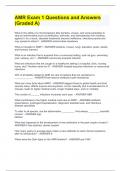AMR Exam 1 Questions and Answers (Graded A)
What is the ability of a microorganism (like bacteria, viruses, and some parasites) to stop an antimicrobial (such as antibiotics, antivirals, and antimalarials) from working against it. As a result, standard treatments become ineffective, infections persist and may spread to others? - ANSWER-antimicrobial resistance
What is included in AMR? - ANSWER-bacteria, viruses, fungi, parasites, pests, weeds, and humans (cancer)
What is an infection that is acquired from a communal setting, such as gym, swimming pool, subway, etc.? - ANSWER-community-acquired infection
What are infections that are caught in a healthcare setting (i.e.hospital, clinic, nursing home, etc)? Another name for it? - ANSWER-hospital-acquried infections or nosocomial
infections
39% of all deaths related to AMR are due to bacteria that are resistance to _____________. - ANSWER-last-reserve antibiotics (pan-resistance)
What are 4 key facts about AMR? - ANSWER-biggest threat to global health and food security today, affects anyone and anywhere, occurs naturally (but is accelerated bc of misuse), leads to higher medical costs, longer hospital stays, and inc mortality
The number of ______ infections increases each year. - ANSWER-ABR
What contributes to the higher medical costs due to AMR? - ANSWER-antibiotic prescriptions, prolonged hospitalization, diagnostic tests/lab tests, and infectious disease specialists
To refer to all species, use the abbreviation _________. And always ________ scientific
names> - ANSWER-spp.
italicize
What has happened to the development of new antibiotics in the past couple of years? -
ANSWER-it has declined, alomst ceased
How many years on average does it take a new antibiotic to reach clinical resistance after its introduction? - ANSWER-8
When were the Dark Ages on the AMR timeline? - ANSWER-pre-1940 When was the primordial era on the AMR timeline? Golden? Biochemical? Pharmacologic? Second Dark Age? Target? - ANSWER-1940s, 1950s, 1970s, 1960s, 2000s, 1980s
What factors contribute to AMR in healthcare? (5) - ANSWER-antibiotic usage (over and under), lack of antibiotics, poor sanitation/hygiene, antibiotics in agriculture, and inadequate infection controls in health care facilities
What is the result of a b-lactam antibiotic binding to transpeptidase instead of D-Ala-D-
Ala? - ANSWER-the binding will be covalent and irreversible, causing inhibition of the enzyme, cell wall synthesis, and results in death by lysis
T/F B-lactam antibiotics are more effective in gram positive bactera. - ANSWER-true; gram positive bacteria have more PBPs exposed
What are the 5 derivatives of penicillin? - ANSWER-penicillin G, penicillin V, ampicillin, amoxicillin, and methicillin
What is the hygiene hypothesis? - ANSWER-A lack of early exposure to microbes increases susceptibility to diseases by suppressing natural development of the immune system
What happened in the study of 184 infants whose parents licked their pacifier? - ANSWER-they were less likely to develop immune diseases
Describe the pathway from population to antibiotic resistance: - ANSWER-inc in global population > inc in food demand > inc animal farming > inc transmission of diseases > inc use of antibiotics > inc antibiotic resistance
Why are antibiotics used in farming? - ANSWER-growth promoter (inc animal weight) and infection control (cheaper than hygiene maintenance)
What happened in terms of antibiotics used in farming in 1951? - ANSWER-FDA approved first antibiotics for use in poultry, pork, and beef
What percentage of all antibiotics in the US are used in animals? - ANSWER-~70%
What did the UN General Assembly announce in 2016? - ANSWER-that the use of antibiotics in animals is the leading cause of antibiotic resistance
What is a method of identifying bacterial isolates by directly measuring the DNA sequence variation in housekeeping genes? Which bacteria was found this way? - ANSWER-MultiLocus Sequence Typing (MLST);
E. faecalis ST16




